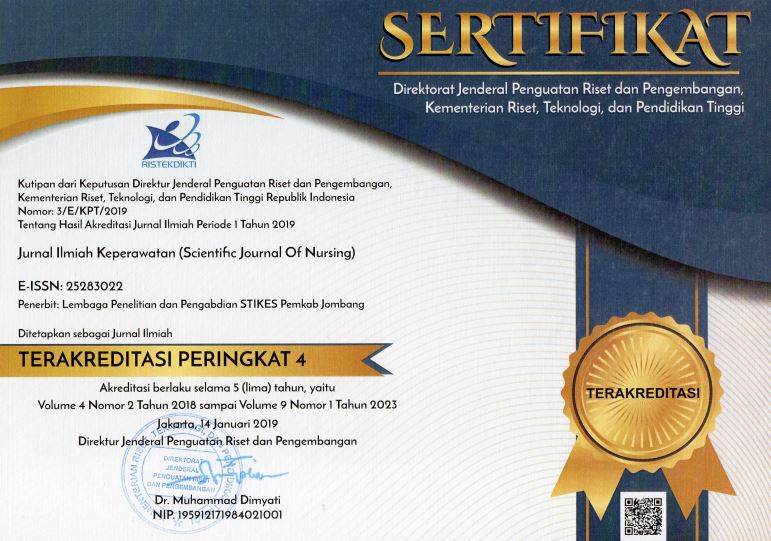PENGARUH DEEP MYOFASCIAL RELEASE TECHNIQUE TERHADAP MYOFASCIAL TRIGGER POINT SYNDROME PADA PUNGGUNG DI KLINIK BLOSSOM MAGELANG
The Effect of Deep Myofascial Release Technique on Myofascial Trigger Point Syndrome on The Back at Blossom Magelang Clinic
DOI:
https://doi.org/10.33023/jikep.v10i2.1901Keywords:
Myofascial Trigger Point Syndrome, , Deep Myofascial Trigger Point SyndromeAbstract
Latar Belakang : Myofascial Trigger Point Syndrome adalah kumpulan titik picu nyeri yang terdapat pada otot muskuloskeletal. Faktor yang memperkuat dan pemicu munculnya MTPS adalah adanya kontraksi otot yang berlangsung secara berkelanjutan, sikap tubuh yang kurang baik, posisi atau gerakan tubuh yang salah dan penataan peralatan kerja yang kurang sesuai yang berakibat pada pola kerja yang tidak ergonomis. Keluhan yang sering ditimbulkan, antara lain: nyeri otot, pegal di sekitar leher dan bahu, kaku, kesemutan pada lengan, sehingga gerak dan fungsinya menjadi terbatas. Keluhan itu juga dapat menyebar ke punggung atas, punggung bawah dan ekstremitas sehingga diperlukan Deep Myofascial Release. Tujuan : Penelitian ini bertujuan untuk mengetahui pengaruh Deep Myofascial Release Technique terhadap Myofascial Trigger Point Syndrome pada Punggung. Metode :Penelitian ini menggunakan rancangan penelitian eksperimental dengan jenis penelitian pre and post test one group design dan 20 partisipan yang merupakan pasien Myofascial Trigger Point Syndrome dan telah memenuhi kriteria inklusi dan eksklusi yang dilakukan 2 kali setiap minggunya selama 1 bulan. Hasil : Pada penelitian ini menggunakan uji normalitas dengan Shapiro Wilk Test untuk pre test ( p = 0.17 ) dan post test ( p = 0.15 ), uji hipotesa menggunakan Paired T-Test 0,000 < ? (?= 0.05) terdapat pengaruh tindakan Deep Myofascial Release Technique terhadap Myofascial Trigger Point Syndrome pada pasien di Klinik Blossom Magelang. Kesimpulan : Terdapat pengaruh pada pemberian Deep Myofascial Release Technique pada pasien Myofascial Trigger Point Syndrome
Downloads
References
Atmadja, A. S. (2016). Sindrom Nyeri Myofascial. Continuing Medical Education, 176-178.
Chaitow, L. (2014). Fascial dysfunction: Manual therapy approaches. Journal of Bodywork and Movement Therapies, 141-150.
Cyganska, A. K., & Tomaszewski, P. (2021). Pain threshold in selected trigger points of superficial muscles of the back in young adults. PeerJ.
Gerwin, R. D. (2018). Myofascial Pain Syndrome. NCBI, 17-23.
Gorman,N. (2022). Supraspinatus Muscle KenHub. https://www.kenhub.com/en/library/anatomy/supraspinatus-muscle
Hammer, W. I. (2019). Functional Soft-Tissue Examination and Treatment by Manual Methods: New Perspectives. Jones & Bartlett Publishers.
Hughes, T., Beaton, K., & Kumar, S. (2014). The effectiveness of massage therapy for the treatment of nonspecific low back pain : A systematic review of systematic review. International Journal of General Medicine, 527-541.
Husnayati, M., & Zaidah , L. (2021). Pengaruh Myofascial Trigger Point Release dan Myofascial Release. Jurnal kesehatan Al-Irsyad, 109-111.
Jafri, M. S. (2014). Mekanisme nyeri myofascial. Hindawi, 1-16.
Jauri, D. (2014). Gambaran nilai Vas (Visual Analogue Scale). ejournal unsrat, 1.
Jhon, S. (2019). Anatomi dan Fisiologi Otot Manusia. Penerbis ABC.
Maney, M., Bukiet, B., & Chaudhry, H. (2019). Three-dimensional mathematical model for deformation of human fasciae in manual therapy. Journal of the Mechanical Behavior of Biomedical Materials, 153-163.
Myers, T. W. (2014). Anatomy trains: myofascial meridians for manual and movement therapists. Elsevier Health Sciences.
Polit, D. F., & Beck, C. T. (2017). Generating and assessing evidence for nursing practice. Wolters Kluwer Health.
Putra, M. P., & all, E. (2020). Combined Deep Transverse Friction and Muscle Energy. Physical Therapy Journal of Indonesia (PTJI).
Rahmanto, S., Yuliardawati, N. M., Kusumawardana, R., & Rosadi, R. (2021). Analisa Risiko Terajadinya Keluhan. PhysioHS, 28.
Ramdan , I. M., & Laksmono, T. B. (2012). Determinan Keluhan Muskuloskeletal pada Tenaga Kerja. Jurnal Kesehatan Masyarakat Nasiona, 168-170.
Ravichandran, P., & Ponni, H. K. (2016). Effectiveness of Deep Release on Myofascial Trigger Point . IJPHY, 3(2), 186-192.
Roberto. (2022). Anatomy of Levator scapulae muscle. Earth's Lab.
Schleip, R., & Muller, D. G. (2013). Training principles for fascial connective tissues: Scientific foundation and suggested practical applications. Journal of Bodywork and Movement Therapies, 103-115.
Sikdar, S., Shah, J. P., & Thaker, N. (2015). Myofascial Trigger Points Then and Now : A Historical and Scientific Perspective. PM & R, 746-761.
Siregar, P., Pramono, A., & Siregar, Y. (2017). Prevalensi myofascial trigger point syndrome pada populasi umum di Indonesia. Jurnal Kedokteran dan Kesehatan Indonesia, 63-68.
Smith, J. (2019). Exploring the Role of Fascia in Human Anatomy. Journal of Anatomy, 45-60.
Stecco, C. (2019). Fascial Manipulation for Musculoskeletal Pain. Piccin Nuova Libraria.
Stella. (2021). Diagnosa and Treatment of Myofascial Pain Syndrome. Jurnal sinaps, 1-7.
Varracallo, M., & all, e. (2023). Anatomy, Head and Neck, Sternocleidomastoid Muscle. National Library of Medicine.
Wijayanto, A. (2019). Anatomi dan Fisiologi Manusia . Penerbit Andi.
Published
How to Cite
Issue
Section
Authors who publish with Jurnal Ilmiah Keperawatan (Scientific Journal of Nursing) agree to the following terms:
- Authors retain copyright and grant Jurnal Ilmiah Keperawatan (Scientific Journal of Nursing) the right of first publication with the work simultaneously licensed under a Creative Commons Attribution 4.0 International License that allows others to remix, adapt and build upon the work with an acknowledgment of the work's authorship and of the initial publication in Jurnal Ilmiah Keperawatan (Scientific Journal of Nursing).
- Authors are permitted to copy and redistribute the journal's published version of the work (e.g., post it to an institutional repository or publish it in a book), with an acknowledgment of its initial publication in Jurnal Ilmiah Keperawatan (Scientific Journal of Nursing).









